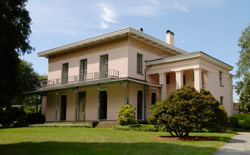Wesleyan’s Alsop House Named National Landmark

The Davison Art Center/Richard Alsop IV House, located at 301 High Street in Middletown, was designated a national historic landmark in January. The site was recognized for its role in U.S. history.
The landmark was suggested by the National Park System’s advisory board and designated by Interior Secretary Dirk Kempthorne.
The historic Alsop House is a distinguished architectural monument of the pre-Civil War period. The lot was acquired in 1835 and the house was built between 1838-1840 by Richard Alsop IV, son of the poet and “Hartford wit,” Richard Alsop III. Originally built for Alsop’s widowed mother, Maria Pomeroy Alsop Dana, the house remained in the Alsop family (although not occupied by them for a number of years) until 1948. In that year, it was purchased by Wesleyan with funds given by Harriet and George W. Davison, class of 1892.
The house has been described as an important example of Romantic Classicism in American architecture.
According to the Department of the Interior, the Alsop House is nationally significant for its “exterior and interior wall paintings that are considered to be exceptional in their scope and artistic quality. The frescoes, long acknowledged by scholars as important, were created in two or more campaigns between 1839 and ca. 1860 by skilled European artist-émigrés. Edward B. Allen was the first art historian to place their significance within the broader historical context of American decorative arts, noting in 1926: “their superior execution, classical inspiration, fine rich color, and excellent drawing and decorative quality.” In 1980, the Metropolitan Museum of Art in New York selected the painted stone walls and other painted elements of the Alsop House stair hall for reproduction in a new American Wing gallery. More recently, Peter Kenny, the curator of American Decorative Arts at the Met, described the Alsop frescoes as “unique and irreplaceable treasures [which] are truly part of our national cultural patrimony.”

